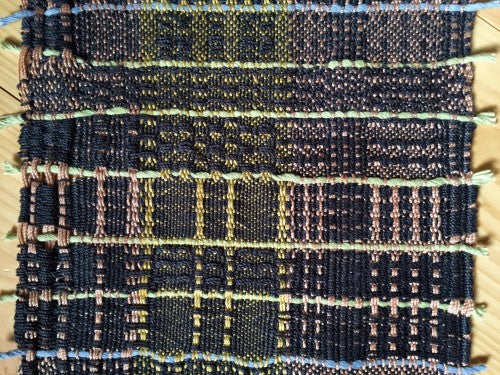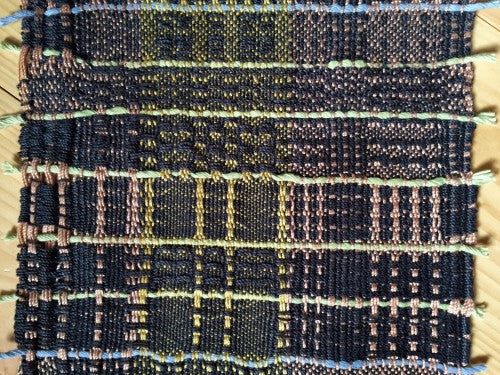By Melissa Ludden Hankens
As I started researching lace weaves, I quickly came to the realization that this topic is far too vast to be covered in a single article. As Jane covers hand-manipulated weaves so well in her book, The Weaver’s Idea Book, I decided to focus on loom-controlled lace weaves on my Schacht floor loom for this sampler, more specifically on Bronson lace, Swedish lace, and huck.
The sampler consists of three columns of threadings typical for each weave structure, divided by warp color in the sampler and a white space in the drawdown for clarity. There are various tie-up and treadling sequences that best highlight each weave structure.
The top section of treadlings and the right column apply to Bronson lace.
The middle column and middle section of the treadling sequences apply to Swedish lace.
The left column and bottom section of treadling sequences are for huck.
Each section of treadling sequences appropriate for the given weave structure is separated by a white line in the drawdown, and various options within each group are separated by green lines.
If you would like to follow along with a draft, download the PDF.
Bronson Lace
Let’s look at Bronson Lace (the right section of warp threads), also referred to as Lace Bronson and Atwater-Bronson Lace. This sampler assumes you are using a four-shaft loom. When looking at Bronson Lace threadings, it is immediately apparent that half of the threads, every other one, are threaded on a single shaft, usually the front one. The other threads are the pattern block threads and are threaded on shafts two, three and four. Plain weave would be treadled 1, 2-3-4, repeat. We learn from Ms. Atwater that you must repeat your pattern blocks more than once to create lace-like open areas, and for the best result, linen or fine worsted yarns should be used. I highly recommend this article by Mary Meigs Atwater for some historical background on this weave structure. It reminded me of the telephone game!
Anne Dixon provides further insight into Bronson Lace in her book, The Handweaver’s Pattern Directory, noting that the pattern blocks consist of an even number of ends, six and four are demonstrated in the sampler. Floats can be created in both the warp and the weft.

Swedish Lace
Up next is Swedish Lace, at the center of the sampler. On a four-shaft loom, two pattern blocks are possible with this weave structure, and each block consists of an odd number of threads. Every other pick or row in the pattern block is a plain weave pick. If you picture a five-thread pattern block, picks one, three and five will float, and picks two and four are plain weave. The end result is that the three floating picks snuggle right up to each other when washed with the plain weave picks providing stability.
Marguerite Porter Davison, in A Handweaver’s Pattern Book, provides some useful tips and threadings. In particular, some of her threadings group threads in a single dent and/or leave adjacent dents open to enhance the lace effect. Additionally, she reminds us not to beat our threads too hard. Changing your shed before beating your pick into place can offer additional resistance if you find this challenging.

Huck Lace
The final loom-controlled lace weave structure we’ll experiment with is huck, short for Huckaback. This is found in the left hand column of the sampler. Not surprisingly, you have two pattern blocks available for your four-shaft loom. They begin and end on the same shaft and consist of an odd number of threads. Typically each block consists of five threads, but three or seven are also an option. As with the first two weave structures, both warp and weft floats are possible.
As I began to weave, I quickly noticed that my tension needed to be notched up in order to provide enough resistance for an easy, even beat. The goal is to be gentle when beating your weft into place. I also found that it was easy to end up with a fell line that was uneven when the pattern combined larger areas of plain weave surrounded by more open lacey areas – something to keep in mind when weaving a length of cloth with this combination. You may be tempted to beat with more force, but be sure to pay attention to your plain weave areas to keep them balanced (even exposure of warp and weft).
A couple of other notes. I used 3/2 pearl cotton for this sampler. I was thrilled with the way the fabric transformed in the washing machine and dryer. I tossed this in with a regular load of wash – no delicate handling of the material. It was also interesting to see how tie-up and treadling sequences appropriate for one weave structure worked for another. There were wins and losses, as you can see in the photos.
Weave the sampler, or choose a section that looks appealing to try on its own. Experiment with treadling sequences and tie-up options. Consider this drawdown a starting point for your own lace explorations. Personally, I’m going to bust out some hemp yarn and make a few towels using the first twelve threads in the Bronson column with the first tie-up and treadling sequence in the huck section. Mix and match!


